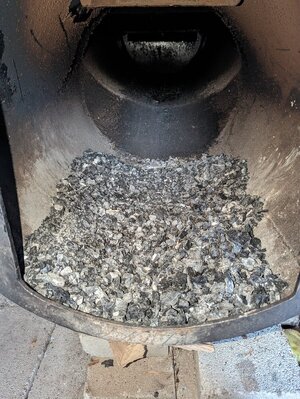- Feb 23, 2023
- 13
- 6
Hi guys,
Sorry, new member here and I stumbled across these forums whilst Googling offset fire management.
I've had a 94 gallon offset smoker for about 8 months now and am really struggling with maintaining a good coal bed and generally a good, clean fire.
I run the smoker on 100% oak wood air dried to a minimum of 20% moisture (I have a moisture meter so this is something that I check regularly) with a split size of around 8 inches by 2 inches. For the first few months of ownership I was running it at far too high a temperatures (350-400f). It transpired that the Tel-Tru gauge was inaccurate due to the prong being too short! Once I discovered this, and learned to ignore it and just use my Fireboard ambient temperature probe in the middle of the smoker, I really struggle to maintain a good temperature of around 250-275f whilst also maintaining a good coal bed.
The longer the cook goes on for the worse this becomes as the unburned wood turns into small lumps of charcoal and starts to restrict airflow, I guess. The attached picture shows what I'm left with in the firebox after an 8 hour cook. This doesn't seem right to me.

I'm now using a grate in the bottom of the firebox, which certainly helps, initially at least, but only if I bash the coals through the grate. If I place logs directly onto the coals it all just tends to go out.
The attached PDF shows the specs of the smoker that I'm running.
I've raised these issues with the builder of the smoker and one of his suggestions was to extend the stack but this would mean me having to post it to him and be without a useable smoker for the duration. As I run this as a business this isn't something that I can do. Plus, I don't feel that it is the correct solution.
I'm getting to a point where I just want to replace the smoker however I just simply can't afford to given the costs of these things over in the UK.
Any suggestions you guys have would be greatly appreciated.
Cheers,
Ben.
Sorry, new member here and I stumbled across these forums whilst Googling offset fire management.
I've had a 94 gallon offset smoker for about 8 months now and am really struggling with maintaining a good coal bed and generally a good, clean fire.
I run the smoker on 100% oak wood air dried to a minimum of 20% moisture (I have a moisture meter so this is something that I check regularly) with a split size of around 8 inches by 2 inches. For the first few months of ownership I was running it at far too high a temperatures (350-400f). It transpired that the Tel-Tru gauge was inaccurate due to the prong being too short! Once I discovered this, and learned to ignore it and just use my Fireboard ambient temperature probe in the middle of the smoker, I really struggle to maintain a good temperature of around 250-275f whilst also maintaining a good coal bed.
The longer the cook goes on for the worse this becomes as the unburned wood turns into small lumps of charcoal and starts to restrict airflow, I guess. The attached picture shows what I'm left with in the firebox after an 8 hour cook. This doesn't seem right to me.

I'm now using a grate in the bottom of the firebox, which certainly helps, initially at least, but only if I bash the coals through the grate. If I place logs directly onto the coals it all just tends to go out.
The attached PDF shows the specs of the smoker that I'm running.
I've raised these issues with the builder of the smoker and one of his suggestions was to extend the stack but this would mean me having to post it to him and be without a useable smoker for the duration. As I run this as a business this isn't something that I can do. Plus, I don't feel that it is the correct solution.
I'm getting to a point where I just want to replace the smoker however I just simply can't afford to given the costs of these things over in the UK.
Any suggestions you guys have would be greatly appreciated.
Cheers,
Ben.





